
ĐỀ MINH HỌA TỐT NGHIỆP LỚP 12
NĂM HỌC: 2024 – 2025
Read the following passage and mark the letter A, B, C, or D on your answer sheet to indicate the correct
word or phrase that best fits each of the numbered blanks from 1 to 6.
Rock began in the USA in the early 1950s. At that time 'rhythm and blues' music was very (1)_______ with
black Americans. 'R&B' was a mixture of black religious music and jazz. It had strong rhythms (2)_______
you could dance to and simple, fast music.
Noticing the success of R&B music, white musicians started to copy the same style. By the mid 1950s, this new
while R&B music, called 'rock 'n' roll' had become very popular. Singers like Elvis Presley and Bill Haley
attracted millions of teenage fans. Their music was fast and loud. (3)_______ older people thought that rock 'n'
roll was very dangerous.
By the early 1960s, even rock 'n' roll had become old-fashioned. Many of the songs had begun to sound the
same. It was at that time that a new group from England became popular: The Beatles.
The Beatles first started by singing American style songs, (4)_______ they soon developed their own style,
with more complicated melodies. They also introduced different instruments, such as the Indian sitar. Groups
like The Beatles had a very important influence on the style of popular music. By the (5)_______ 1970s, rock
'n' roll had developed into (6)_______ new form of music. Electronics had replaced the amplified guitars and
drums of rock 'n' roll. Rock had arrived.
Question 1: A. accepted B. popular C. famous D. common
Question 2: A. who B. what C. that D. whom
Question 3: A. Little B. Many C. Few D. Much
Question 4: A. and B. but C. so D. for
Question 5: A. early B. opening C. first D. advance
Question 6: A. a B. the C. an D. no article
Read the following passage and mark the letter A, B, C, or D on your answer sheet to indicate the correct
word or phrase that best fits each of the numbered blanks from 7 to 13.
ANNOUNCEMENT OF SCHOOL REOPENING
We are excited to announce we will officially resume in-person classes on 20th March! We truly appreciate the
outpouring of support over the past several weeks. Our community has come together in so many ways and has
exemplified the true meaning of having a black belt mentality. Because we care for your health and safety, we
ask that you take note of some policy updates we’ve (7)_______ to ensure we are adhering to the highest
standard with physical distancing and sanitization procedures. How you can help keep our building healthy and
clean:
• Parents (8)______ to please drop off and pick up students. This helps us to reduce the group sizes within our
facility. We will stream our classes live, so you can watch your children (9)_______ class and be ready for pick
up when class wraps up.
• Students should arrive ready to train in their uniforms.
• Everyone should keep moving after classes. We understand you haven’t seen your [Business Name] friends in
a while, but we must continue to maintain (10) _______ distancing and also allow the staff time to disinfect.
• You should expect to show up for class no more than 5 minutes ahead of the start time to minimize (11)
______ people in the building.
• We will be checking temperatures using a touch-free Infrared forehead thermometer. Please expect this before
you enter the building.
(12) _________ you have any questions, please contact us.
Question 7: A. implemented B. occured C. activated D. illustrated
Question 8: A. are asked B. are asking C. askes D. have asked
Question 9: A. do at B. go in C. check out D. participate in

Question 10: A. social B. society C. antisocial D. antisociety
Question 11: A. a number of B. the number of C. little D. a little
Question 12: A. Should B. Had C. Were D. Do
Mark the letter A, B, C, or D to indicate the correct arrangement of the sentences to make a meaningful
paragraph in each of the following questions.
Question 13:
A. Lan: It's not far. Go to the end of the High Street and turn right. Go straight on and it's on the left.
B. Peter: Excuse me. Where's the nearest post office?
C. Peter: Thanks!
A. b - a - c B. c - a - b C. b - c - a D. a - b - c
Question 14:
Dear Mom,
A. Thank you for being my pillar of strength.
B. Finally, I want to assure you that your love and wisdom continue to inspire me, and I am truly blessed to
have you as my mother.
C. Additionally, I appreciate the sacrifices you've made to ensure my well-being and happiness.
D. Firstly, I want to express my deepest gratitude for your unwavering love and support throughout my life.
e. Your guidance and encouragement have shaped me into the person I am today.
With love,
A. d - c - e - b - a B. d- e - c - b - a C. d - c - e - a- b D. d - c - b- e - a
Question 15:
A. The weather was perfect for a day at the beach.”
B. We packed our bags with sandwiches, fruits, and cold drinks.”
C. As the sun set, we packed up our things and headed home, tired but happy.”
D. We spent the day building sandcastles, playing beach volleyball, and swimming in the sea.
e. It was a day well spent with family.
A. a - b - d - c - e B. b - a - d - e - c C. a - b - c - d - e D. b - a - c - d - e
Question 16:
A. Cross-cultural learning has three main benefits.
B. Secondly, it allows us to learn new ways of thinking and problem-solving by exchanging ideas with others.
C. Finally, it encourages us to appreciate diversity and work together with people from various cultures
D. Firstly, it helps understand and respect different backgrounds, making us more open-minded.
e. So it is important to learn about different cultures around the world.
A. e - b - d - a - c
B. a - d - b - c - e
C. a - c - d - b - e
D. e - d - b - c - a
Question 17:
A. The first stage is commonly referred to as the honeymoon phase.
B. Then people experience frustration stage as the excitement of being in a new environment disappears.
C. People who experience culture shock may go through four phases.
D. During the acceptance stage - the final one, people are better able to experience and enjoy their new home.
e. The third stage is the adaptation stage when people feel more at home in their new surroundings.
A. d - c - e - a - b
B. c - a - b - e - d
C. c - e - a - b - d
D. a - b - c - e - d

Mark the letter A, B, C, or D on your answer sheet to indicate the correct option that bestfits each of the
numbered blanks from 18 to 23.
Nowadays, media development has many positive influences in human’s life. People have lots of sources to get
information and take entertainment such as television, radio, Internet, etc. but nobody can deny the importance
as well as the benefits of reading books.
First, reading books helps us widen our knowledge. Vietnamese has a proverb which means (18)_______, if we
always stay at home with our mother, we will never be wise. However, nowadays, not only does reading books
costs less money but it is also more comfortable than taking a trip. We just lie on the couch and comprehensive
what is happening in the books. Thanks to the wide range of books such as science, literature, astronomy,
archeology, biology, physics, etc. we can get information focus on our own fields as well as the others. The
more books we have read, the more knowing we have obtained.
Secondly, reading books helps us improve our expression ability like writing and speaking. The writing style of
some our favorite writers will affect ours. Especially, (19 _______, we will not only know more about that
country but also have chance to improve our reading skill, learn new words which can be used to better our
essays.
Last but not least, reading books helps us relax after a hard-working day. It is also an interest for everybody
who does not like to visit crowded places at the weekend. They like quiet atmosphere and (20)______.They
meet their stories, their lives in books (21) _______. Reading books makes them happy and relieve stress.
In conclusion, reading books is so important and has many benefits. It not only (22) ______ become more
clever but also bring us happiness. Therefore, everyone should be encouraged to read books as much as
possible.
Question 18:
A. That we should travel to broad our understanding
B. Which we should travel to broad our understanding
C. travel to broad our understanding
D. It makes to broad our understanding
Question 19:
A. when we read foreign literature
B. read to foreign literature
C. to read foreign literature
D. Having read to foreign literature
Question 20:
A. do not want to disturb anybody so they consider books as their close friend.
B. wanting to disturb anybody so they consider books as their close friend.
C. to want to disturb anybody so they consider books as their close friend.
D. to want disturb anybody so they consider books as their close friend.
Question 21:
A. and extremely sympathetic they feel with the characters’ situations
B. and they feel extremely sympathetic with the characters’ situations
C. extremely sympathetic they feel with the characters’ situations
D. with the characters’ situations extremely sympathetic they feel with
Question 22: A. help us B. help we C. help me D. help them
Read the following passage and mark the letter A, B, C, or D on your answer sheet to indicate the correct
answer to each of the questions from 23 to 30.
Since water is the basis of life, composing the greater part of the tissues of all living things, the crucial problem
of desert animals is to survive in a world where sources of flowing water are rare. And since man’s inexorable
necessity is to absorb large quantities of water at frequent intervals, he can scarcely comprehend that many
creatures of the desert pass their entire lives without a single drop.

Uncompromising as it is, the desert has not eliminated life but only those forms unable to withstand its
desiccating effects. No moist- skinned, water-loving animals can exist there. Few large animals are found. The
giants of the North American desert are the deer, the coyote, and the bobcat. Since desert country is open, it
holds more swift-footed running and leaping creatures than the tangled forest. Its population is largely
nocturnal, silent, filled with reticence, and ruled by stealth. Yet they are not emaciated.
Having adapted to their austere environment, they are as healthy as animals anywhere else in the word. The
secret of their adjustment lies in the combination of behavior and physiology. None could survive if, like mad
dogs and Englishmen, they went out in the midday sun; many would die in a matter of minutes. So most
of them pass the burning hours asleep in cool, humid burrows underneath the ground, emerging to hunt only by
night. The surface of the sun-baked desert averages around 150 degrees, but 18 inches down the temperature is
only 60 degrees.
Question 23: The author mentions all the following as examples of the behavior of desert animals EXCEPT
_______.
A. they are watchful and quiet B. they sleep during the day
C. they dig home underground D. they are noisy and aggressive
Question 24: We can infer from the passage that ______.
A. healthy animals live longer lives B. living things adjust to their environment
C. desert life is colorful and diverse D. water is the basis of desert
Question 25: According to the passage, creatures in the desert ________.
A. are smaller and fleeter than forest animals
B. are more active during the day than those in the tangled forest
C. live in an accommodating environment
D. are not as healthy as those anywhere else in the world
Question 26: The phrase “those forms” in the passage refers to all of the following EXCEPT _______.
A. moist-skinned animals B. many large animals
C. water-loving animals D. the coyote and the bobcat
Question 27: The word “them” means ________.
A. animals B. minutes C. People D. water
Question 28: The word “them” means_________.
A. animals B. minutes C. people D. water
Question 29: Man can hardly understand why many animals live their whole life in the desert, as _______.
A. water is an essential part of his existence
B. very few large animals are found in the desert
C. sources of flowing water are rare in a desert
D. water composes the greater part of the tissues of living things
Question 30: The title for this passage could be _______.
A. “Man’s Life in a Desert Environment” B. “Desert Plants”
C. “Animal Life in a Desert Environment” D. “Life Underground”
Read the following passage and mark the letter A, B, C, or D on your answer sheet to indicate the correct
answer to each of the questions from 31 to 40.
Plants and animals will find it difficult to escape from or adjust to the effects of global warming. Scientists have
already observed shifts in the lifecycles of many plants and animals, such as flowers blooming earlier and birds
hatching earlier in the spring. Many species have begun shifting where they live or their annual migration
patterns due to warmer temperatures. With further warming, animals will tend to migrate toward the poles and
up mountainsides toward higher elevations. Plants will also attempt to shift their ranges, seeking new areas as
old habitats grow too warm. In many places, however, human development will prevent these shifts. Species
that find cities or farmland blocking their way north or south may become extinct. Species living in unique
ecosystems, such as those found in polar and mountaintop regions, are especially at risk because migration to

new habitats is not possible. For example, polar bears and marine mammals in the Arctic are already threatened
by dwindling sea ice but have nowhere farther north to go. Projecting species extinction due to global warming
is extremely difficult. Some scientists have estimated that 20 to 50 percent of species could be committed to
extinction with 2 to 3 Celsius degrees of further warming. The rate of warming, not just the magnitude, is
extremely important for plants and animals. Some species and even entire ecosystems, such as certain types of
forest, may not be able to adjust quickly enough and may disappear. Ocean ecosystems, especially fragile ones
like coral reefs, will also be affected by global warming. Warmer ocean temperatures can cause coral to
“bleach”, a state which if prolonged will lead to the death of the coral. Scientists estimate that even 1 Celsius
degree of additional warming could lead to widespread bleaching and death of coral reefs around the world.
Also, increasing carbon dioxide in the atmosphere enters the ocean and increases the acidity of ocean waters.
This acidification further stresses ocean ecosystems.
From "Global Warming" by Michael Mastrandrea and Stephen H. Schneider
Question 31: Scientists have observed that warmer temperatures in the spring cause flowers to ______.
A. die instantly B. bloom earlier C. become lighter D. lose color
Question 32: According to paragraph 2, when their habitats grow warmer, animals tend to move ______.
A. south-eastwards and down mountainsides toward lower elevations
B. north-westwards and up mountainsides toward higher elevations
C. toward the North Pole and down mountainsides toward lower elevations
D. toward the poles and up mountainsides toward higher elevations
Question 33: The pronoun “those” in paragraph 2 refers to ______.
A. species B. ecosystems C. habitats D. areas
Question 34: The phrase “dwindling sea ice” in paragraph 2 refers to ______.
A. the frozen water in the Arctic B. the violent Arctic Ocean
C. the melting ice in the Arctic D. the cold ice in the Arctic
Question 35: It is mentioned in the passage that if the global temperature rose by 2 or 3 Celsius degrees,
______.
A. half of the earth’s surface would be flooded
B. the sea level would rise by 20 centimeters
C. water supply would decrease by 50 percent
D. 20 to 50 percent of species could become extinct
Question 36: According to the passage, if some species are not able to adjust quickly to warmer temperatures,
______.
A. they may be endangered B. they can begin to develop
C. they will certainly need water D. they move to tropical forests
Question 37: The word “fragile” in paragraph 4 most probably means ______.
A. very large B. easily damaged C. rather strong D. pretty hard
Question 38: The bleaching of coral reefs as mentioned in paragraph 4 indicates ______.
A. the water absorption of coral reefs
B. the quick growth of marine mammals
C. the blooming phase of sea weeds
D. the slow death of coral reefs
Question 39: The level of acidity in the ocean is increased by ______.
A. the rising amount of carbon dioxide entering the ocean
B. the decrease of acidity of the pole waters
C. the extinction of species in coastal areas
D. the loss of acidity in the atmosphere around the earth
Question 40: What does the passage mainly discuss?
A. Influence of climate changes on human lifestyles
B. Effects of global warming on animals and plants



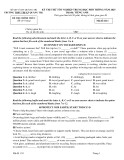
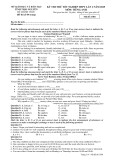
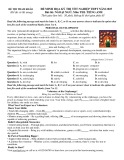



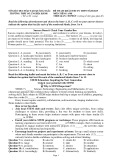
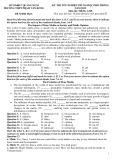


![Đề thi tiếng Anh tốt nghiệp THPT 2025 (Chính thức) kèm đáp án [mới nhất]](https://cdn.tailieu.vn/images/document/thumbnail/2025/20250627/laphong0906/135x160/9121751018473.jpg)








![11 chủ đề ôn tập môn Toán lớp 2 [chuẩn nhất]](https://cdn.tailieu.vn/images/document/thumbnail/2025/20250613/phuongnguyen2005/135x160/74791749803387.jpg)



